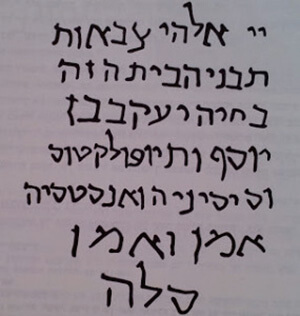 Part I
Part I
Background and Some Rabbinic Pre-Arab Sources
We have learned in Seder Eliyahu Rabbah (Chapter 28, ed. Friedman, p. 149):
Once, Rabbi Zadok (late 1st c.) entered the Temple and saw it destroyed. He said: My father who is in heaven, You destroyed Your city and burned Your Temple and yet you sat by tranquilly and remained silent…On another occasion, Rabbi Natan (early 2nd c.) entered the Temple and found the Temple destroyed but for one wall still standing.
Tosefta Berachot (6:2, ed. Lieberman, p. 33 and parallels):
Ben Zoma (early 2nd c.), when he saw a large mass of Jews on the Temple Mount, used to say: Blessed is He who created all the people to serve me…”
Yerushalmi (Pesahim 7:11, ed. Venice 35b):
Said R. Yohanan ben Maryah (4th c. Israel) in the name of R. Pinchas: From the fact that we see the sages removing their sandals under the portals of the wall (surrounding the) Temple Mount, we can derive that under the portal was not sanctified.
R. Pinchas is saying that since the sages took off their sandals under the portal according to the law that it is forbidden to enter the Mount wearing shoes (Berachot 9:5), the portal is therefore not part of the Temple Mount. From here we can deduce that the sages of that period did indeed enter the Temple Mount on a regular basis.
The Christian Pilgrim of Bordeaux, who was in Jerusalem around the year 333 CE, relates that the Jews used to come to the Temple Mount every year on the Ninth of Av in order to recite lamentations over the Temple ruins and to rend their garments. He adds that next to two monuments of Hadrian there was a perforated stone upon which the Jews used to pour oil 1].
The Muslim Conquest of The Land of Israel
At the time of the Muslim conquest of the Levant, a large Jewish population still lived in Palestine (see, for instance, the question posed in JT Demai 22c on whether most of Eretz Yisrael is in the hands of the gentiles or whether the greater part is in the hands of Israel). We do not know whether they formed a majority, but we may assume with some certainty that they did so when grouped with the Samaritans. Significant Jewish population in places like Acre, Haifa, Sephoris and Eilat (Ayla) are attested to directly and indirectly by Christian and Muslim sources such as Procopius and the anonymous tract “The Didaskalia of Jacob, the Recently Baptized.” (On Sephorris, there is the famous statement that Muhammed is said to have made to Uqba b. Ali, a descendant of Umaya: “You are a Jew from the Jews of Sephoris.”.
In the biography of the monk-soldier Bar Sawma who was active in the area in the fifth century, it is told that the Jews and Samaritans virtually governed the land and they persecuted the Christians. Bar Sawma led a campaign against this Jewish-Samaritan front, presumably with the assistance of a Byzantine army. The Jewish-Samaritan forces were said to have consisted of 15,000 armed men. The Jews were defeated and Bar Sawma describes the ensuing destruction on the Jewish towns and villages. On one synagogue in the city of Reqem of Gaya (Petra), he remarks, “It could bear comparison only to Solomon’s Temple.”
In about the year 425, the Jews of the Galilee and its surroundings applied to the empress Eudocia to permit them to pray on the ruins of Solomon’s Temple in Jerusalem, as they had forbidden to do so since Constantine. The empress relented. The author of the aforementioned biography cites a letter purportedly written by the Jews of Galilee to the Jewish communities in Rome and Persia:
To the great and elevated nation of the Jews, from the Priest and Head of Galilee, many greetings. Ye shall know that the time of the dispersion of our people is at an end, and from now onward the say of our congregation and salvation has come, for the Roman kings have written a decree to hand over our city of Jerusalem to us. Therefore come quickly to Jerusalem for the coming holiday of Sukkot, for our kingdom is established in Jerusalem.
And indeed, 103,000 Jews came and gathered in Jerusalem but they were struck by calamity where—in the biographer’s version—“big stones rained from the sky” whereas the Jews complained to the empress that they were attacked by hostile monks.
Some historians have understandably cast doubt on the version of events cited there. Some have cast serious doubt on the stories relating to the Jews since he lived a century after the events described. Moshe Gil retorts that “this is a facile way of dismissing ancient sources. We must not disregard or refute their contents even if they appear legendary in character; they still retain a germ of historical truth” 2].
There were no less than four Samaritan revolts against Byzantine rule from the year 484 to 555.
The period preceding the Arab conquest was undoubtedly a period of decline and internal disintegration of the Byzantine Empire. After a series of assassinations and wars with Persians and Longobards, a new emperor gained the throne of Byzantium in 610, Heraclius. But the longed-for peace would be short-lived, as the Persians renewed their campaign against the empire. In this the Persians were aided in no small part by their Jews as well as the Jews they encountered along the way. Jews fought in the Persian army and, according to one contemporary chronicle, they were so influential as to gain exemption from fighting on the Sabbath.
(Continued next week)
By Joel Davidi Weisberger










